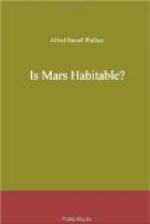As the result of such an origin as that suggested, Mars would possess a structure which, in the essential feature of heat-distribution, would be the very opposite of that which is believed to characterise the earth, yet it might have been produced by a very slight modification of the same process. This peculiar heat-distribution, together with a much smaller mass and gravitative force, would lead to a very different development of the surface and an altogether diverse geological history from ours, which has throughout been profoundly influenced by its heated interior, its vast supply of water, and the continuous physical and chemical reactions between the interior and the crust.
These reactions have, in our case, been of substantially the same nature, and very nearly of the same degree of intensity throughout the whole vast eons of geological time, and they have resulted in a wonderfully complex succession of rock-formations—volcanic, plutonic, and sedimentary—more or less intermingled throughout the whole series, here remaining horizontal as when first deposited, there upheaved or depressed, fractured or crushed, inclined or contorted; denuded by rain and rivers with the assistance of heat and cold, of frost and ice, in an unceasing series of changes, so that however varied the surface may be, with hill and dale, plains and uplands, mountain ranges and deep intervening valleys, these are as nothing to the diversities of interior structure, as exhibited in the sides of every alpine valley or precipitous escarpment, and made known to us by the work of the miner and the well-borer in every part of the world.
Structural Straight Lines on the Earth.
The great characteristic of the earth, both on its surface and in its interior, is thus seen to be extreme diversity both of form and structure, and this is further intensified by the varied texture, constitution, hardness, and density of the various rocks and debris of which it is composed. It is therefore not surprising that, with such a complex outer crust, we should nowhere find examples of those geometrical forms and almost world-wide straight lines that give such a remarkable, and as Mr. Lowell maintains, ‘non-natural’ character to the surface of Mars, but which, as it seems to me, of themselves afford prima facie evidence of a corresponding simplicity and uniformity in its internal structure.
Yet we are not ourselves by any means devoid of ‘straight lines’ structurally produced, in spite of every obstacle of diversity of form and texture, of softness and hardness, of lamination or crystallisation, which are adverse to such developments. Examples of these are the numerous ‘faults’ which occur in the harder rocks, and which often extend for great distances in almost perfect straight lines. In our own country we have the Tyneside and Craven faults in the North of England, which are 30 miles long and often 20 yards wide; but even more striking




